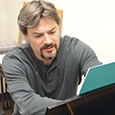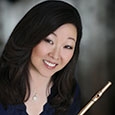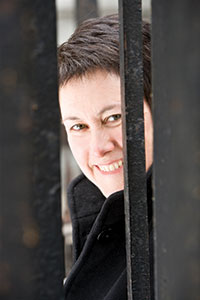
photo by J. Henry Fair
Jennifer Higdon, Pulitzer Prize and Grammy winner, is one of the most performed living American composers working today. She makes her living from commissions coming from a wide range of performers including the Philadelphia Orchestra, The President’s Own Marine Band, Eighth Blackbird, and the Tokyo String Quartet, as well as individual artists such as singer Thomas Hampson and violinist Hilary Hahn. She has written 20 chamber works for flute, and her compositions are recorded on over 60 CDs, including a new recording of Steeley Pause by the Beta Quartet. She will be writing a flute concertino for the NFA for the 50th Anniversary in 2022. She holds the Rock Chair in Composition at The Curtis Institute of Music in Philadelphia. www.jenniferhigdon.com
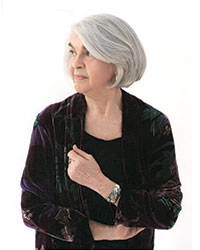
Katherine Hoover, composer, flutist, and poet, is the recipient of a National Endowment Composers Fellowship and many other awards and commissions, including the prestigious Academy of Arts and Letters 1994 Academy Composition Award, and a Lifetime Achievement Award from the National Flute Association. Her works for orchestra, chamber groups, and soloists have been widely recorded and published by Theodore Presser and Papagena Press. Her Kokopeli for solo flute has sold over 12,000 copies and been performed world-wide. Her flute concerto, Four Winds, was premiered by Mark Sparks at the NFA convention in 2014. Her Requiem for the Innocent was recently recorded and presented by the New York Virtuoso Singers, with brass, organ and percussion at New York’s famed Trinity Church. As a flutist she has given concerto performances at Lincoln Center and performed with leading ballet and opera companies in all of New York’s major halls. She has played numerous recitals, live and on radio and television, and recorded solo and chamber repertoire for Arabesque, Leonarda, CRI, Grenadilla, and Opus One. She has taught flute in the Juilliard Preparatory Department.
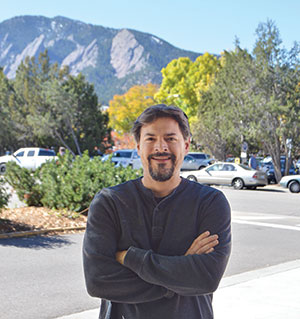
photo by Alexander George
Composer/pianist Carter Pann has written for and worked with musicians around the world including the London Symphony and City of Birmingham Symphony, the Tchaikovsky Symphony in Moscow, many Radio Symphonies around Europe, the Seattle Symphony, National Repertory Orchestra, and countless wind ensembles. He has written for Richard Stoltzman, the Takács Quartet, Antares Ensemble, the Capitol Saxophone Quartet, the West Coast Wind Quintet, the River Oaks Chamber Orchestra and many concert pianists. Pann has received a Charles Ives Fellowship, a Masterprize seat in London and five ASCAP awards over the years. His numerous albums encompass solo, vocal, chamber, orchestral and wind music and have received two Grammy nominations to date. In 2016 he was a Pulitzer Prize Finalist in Music. He lives and teaches in Boulder, Colorado.
Last summer, these three celebrated composers, whose notable works for flute continue to grow in popularity, shared their thoughts in a conference call. All three are active composers, but their professional journeys have taken different and fascinating trajectories.
All three of you began your musical lives as performers. How did this affect your craft as composers?
Katherine Hoover: I started as a flutist when I was quite young, and then I started to compose a bit later. Back in the 1950s and 60s, things were not the same as they are today. Women were not expected to compose. Even when I enrolled in a composition course at the Eastman School of Music, I was the only woman, and the teacher never bothered to look at my work. The other thing was that the flute repertoire was really quite limited back then, and there was a prescribed set of pieces we all learned. In the end, the person who taught me the most about music and about composing was William Kincaid. He gave me many of the basic skills that are still with me every day. I began to write for myself and my friends in my late 20s, and the minute I got to putting pen to paper, I realized that I was never going to leave that, and I am still writing now.
Jennifer Higdon: I started playing the flute in high school. I was self-taught and joined the high school band. I decided to major in music and went off to Bowling Green State University to study with Judith Bentley who was the most incredible teacher. She studied with William Kincaid, too. There is a real connection here to Kincaid.
I was a flute performance major, but Mrs. Bentley was also one of the most astounding composition teachers I have ever had. I still think of her as probably my most influential teacher, and she had the greatest effect on my composing – and that is quite a tribute because I also studied with Ned Rorem and George Crumb. Those flute lessons taught me so much. Every day when I write, and I do write pretty much every day, I think about things that she said. I think she could probably teach anything.
I was a late starter for composition as well, starting in the middle of my undergraduate years. Judith Bentley was the first person to ask me to write something. Many years after finishing school, composing just kind of took over. As commissions started coming in, I began playing the flute less and less. I often make the joke that my flute license has been revoked because I haven’t been playing for the past 12 or 13 years. I still love the instrument, however, and use it a lot in all my orchestra pieces. I am scheduled to write a new work for the National Flute Association in a few years.
Carter Pann: That sounds so familiar to me, but switch the instrument to piano. I grew up in a suburb of Chicago. I went through high school and did some sports, but really the carrot in front of me was the canon of ultra-famous pieces for piano from the past. I wanted to be a pianist, and as I grew and my hands grew, I really started hitting the big repertoire and practicing confidently.
My private teacher in high school was pianist Emilio del Rosario. He may be my greatest mentor, period. That, again, is over William Bolcom and all of these other big names you have heard of. Emilio could have taught anything. He knew music like I never thought anybody could, in detail. He would say to me, “You could write your own impromptu. Have you tried that?” From my childhood, I was an artist and loved to draw. It was that tactile love that got me interested in trying out some things on staff paper very early on. These were little piano ditties, like music box pieces, to play or show off to my friends. I remember they happened to all be in C minor – I don’t know what that’s about.
I attended Eastman and double majored in piano and composition. I had a great piano teacher, Barry Snyder, who was incredibly influential on my composing. I also studied with composer Sam Adler in my first year at Eastman. This man somehow knew my thoughts. He was very sage and such an inspiration.
How did particular musicians, opportunities, or even lack of opportunities contribute to the inspiration behind your writing? What are other sources of inspiration?
Katherine Hoover: I started writing for the flute because it was the instrument I knew best. I submitted a piece to a contest for a local flute club, and they liked it. The flute community was wonderful and always wanted interesting new pieces. Obviously, I have branched out quite a bit from there, but that was the backbone of being known and my work being accepted for years.
The first big piece I wrote was Homage to Bartók (1975) for our wind quintet The Windbag, and the one that made my reputation was Kokopeli, op. 43 (1990) which has now sold 12,000 copies. I have ten pieces, more than anyone else, that have won the NFA’s Newly Published Music Competition. I have stuck with flutists because they have stuck with me!
Jennifer Higdon: I first wrote for flute because my friends were flutists, and we played in flute choirs together. They were the people who were asking me for music. I am so thankful that I played an instrument. When composing, I seriously consider what it is like to be on the other side of the music stand and what performers are experiencing as they look at the page. My earliest successes were because flute players were so enthusiastic about new music.
In June 2002, the Philadelphia Orchestra premiered my Concerto for Orchestra, which had been commissioned in 1998, to celebrate the orchestra’s centennial in the newly built Kimmel Center. My life started to change almost overnight after that premiere, and I only played flute for a couple more years. I could tell that composition was the direction my life was supposed to go, and it felt like putting on an extremely comfortable pair of shoes. I was never aware that composers could have one concert that would actually change their lives. I had heard of that with conductors and performers, but never with a composer. It was completely terrifying.
Carter Pann: You had a Bernstein moment!
Jennifer Higdon: Leonard Bernstein was exactly the person I thought of when it happened. I teach at the Curtis Institute of Music, and Bernstein went to Curtis. We are all very aware that he had that New York Phil moment. It was shocking and fairly scary how quickly everything changed. There was no one I could ask, “How do I handle this?” “What happens now?” I am lucky it all turned out well because it could have gone the other way that night and ended my composing career.
When the Philadelphia Orchestra commissioned the work, they did not know my piece would be programmed on the lead concert, which was the opening concert for a conference they hosted for the League of American Orchestras. Perhaps they heard the Curtis Orchestra perform the premiere of my piece Blue Cathedral (2000) right before that, and it gave them faith to program the Concerto for Orchestra on that particular concert. This meant that the world premiere was in front of about 3,500 orchestra managers. It was a very gutsy move because I was the only composer who was a complete unknown. My piece was the first half of the concert, and Richard Strauss’ Ein Heldenleben was the second half. It worked to my advantage that I was unknown, because expectations were not high.
They had asked for a 35-minute work using all the forces of the orchestra. Because I was local, there were a lot of other composers around town who were wondering how I got this commission, and I was wondering the same thing. I took a long time to write the piece because I thought it might be the only time I got a chance to write a big piece for a big orchestra. Now I kind of laugh about that, but at the time I had no idea.
Carter Pann: I am going to echo what Jennifer said about the enthusiasm that flutists possess for new music. It is funny to be in conversation with three flute players here – flute works are by far the pieces that took me into composition the most.
Bonnie Boyd is the flutist on faculty at Eastman, and when I was in school, she had a huge flute studio – one of those incredibly deep benches of students who were all approachable and enthusiastic. The composition department was rather large at that point as well. I called them the seven astronauts: Samuel Adler, Warren Benson, David Liptak, Robert Morris, Christopher Rouse, Allan Schindler, and Joseph Schwantner. It was a great fusion for me as a student and really fertile ground for me to start composing, especially for flute.
At a very early age, I shed all of my trepidation about sounding derivative. I wanted music to be free-flowing out of me, but obviously crafted and honed. I wasn’t trying and I’m still not trying to break new trails, and I wasn’t trying to scammer around trying to find a voice. Somebody gave me the freedom, or at least I felt it, to think “if you’re going to write a Dixieland rag, do it, and let’s go all the way with it.”
Katherine Hoover: I agree with you.
Jennifer Higdon: Yeah. You’re right, absolutely.
Carter Pann: I wanted to write minuets like Maurice Ravel. This is coming from a pianist’s perspective as well. Now, I feel an appreciation that I might not have had if I started writing like Morton Feldman at the age of 21, or doing something extremely didactic that is a remnant of the 50s. I get slashed a little bit for that, “This is whipped cream; all this kid writes is whipped cream,” but I don’t place any stylistic constraints on myself at all.
Jennifer Higdon: Do you think it is because we started out playing an instrument? I sometimes wonder if people who started out playing an instrument approach their musical language in a different way.
Carter Pann: Oh absolutely. I gravitate towards certain composers over others. I got into the flute world to the degree that I did partly to get away from the piano, and the flute was my first escape. What about you? You probably didn’t grow up on Chopin preludes?
Jennifer Higdon: Yes, I listened to rock and roll. My dad was an artist who worked from home, so I did not grow up around classical music. I often think that probably means that my brain is wired to make musical changes at a different speed. What a composer hears when they are growing up is kind of their entire sound world as they go through life. This also meant that I had to do a lot of catching up on standard repertoire too. My childhood was filled with music that is quite different than the world I work in now. I feel like in some way that has to have filtered through.
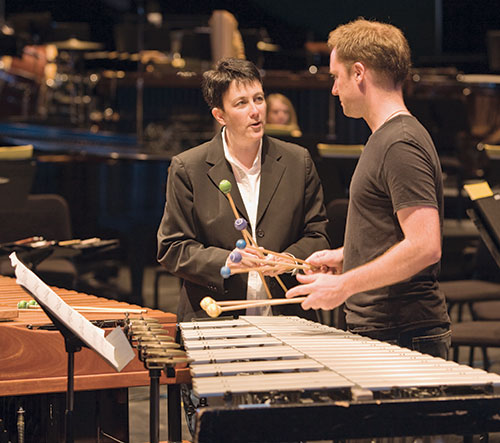
Carter Pann: You bring up a great point. My parents were hitting the Beatles and classic rock all the time, and that is why I am such a Steely Dan junky.
Jennifer Higdon: Yes, the Beatles, the Rolling Stones, Bob Marley, and early reggae. And I listened to all of the late 60s folk rock like Peter, Paul and Mary.
Katherine Hoover: The pop music of my time was Frank Sinatra, Nat King Cole, and Ella [Fitzgerald].
Jennifer Higdon: I am listening to that now!
Katherine Hoover: Big bands and all of that – I grew up listening to anything and everything, especially at night when I was supposed to be asleep. I also listened to all of the classical music I possibly could – I was just a hound for that.
In the 1970s, a number of women composers began to meet each other and get together. In 1977 I began work with the Women’s Inter-Art Center in New York and organized Festivals I through IV of Women’s Music which presented music by fifty-five historical and contemporary women composers with first-class performers. We received a lot of publicity and got a lot of recordings made and played. It drove the guys in New York nuts. It was a terribly difficult time. You should have heard all the names I was called.
Because I did not have a famous composition teacher to go to when I had questions, I did a bit more exploring of ways of writing music. That took a while, and the flute community was my base the whole time. I would try writing things that sounded more contemporary because if you tried writing anything else, heaven help you, it was not accepted. Then, I went out west and heard the way that the Native Americans were playing the flute, and I found new material that really moved me. I began to write for flute using that as inspiration, and that made a big difference. I began to say “the heck with it, I’m going to write what I want.”
Jennifer Higdon: I have to say you are a real warrior, Katherine. I am so impressed by your ability to hold up under what sounds like impossible circumstances and difficult people. I feel like you kicked open a lot of doors for us.
Katherine Hoover: I did not realize how much at the time, but yes, I think I did. It was rough. Among other women my age, you will hear the same story. I don’t think I came into my own sense of what I wanted to write easily or well, but flute helped with that. I knew the flute, and I knew what I wanted to do with it. I love the fact that you are both writing what you please, and no one can tell you any differently. It is beautiful, and I am so pleased for both of you.
Carter Pann: Jennifer said something that resonated with me – the idea of thinking about the player on the other side of the stand. I remember being so inspired when I saw The Capitol Saxophone Quartet perform. I was suddenly like the actor hounding the director saying, “I want the part!” I ran back stage and said, “Let’s do something! I really want to write a saxophone quartet, and I really want to write it for you guys!”
I never do that, but this was too attractive to me. I knew a couple of them already from different contexts, and I knew their playing. I basically tackled them. I just want to be a “player’s composer” a lot of the time.
Jennifer Higdon: A player’s composer is a great way to put it. I always want to know who I am writing for, like when I wrote my Violin Concerto (2008) for violinist Hilary Hahn. She said “I want a major work,” so I had to get her to define what she considered a major work. Hilary kept saying, “make the piece harder,” and that pushed my imagination.
Flutists are game to try anything. I remember when I wrote rapid♦fire (1996) for flutist Peter Brown. He just said, “I want something that is really hard.” When I wrote a flute piece called running the edgE (2001) for Claudia Anderson and Jill Felber for their group ZAWA, they were very specific about what they wanted. I love tailoring pieces to what the performers want in terms of the language, form, and what is going to happen in the piece.
Katherine Hoover: My experience is a little different. The first piece I wrote for flute was Medieval Suite. I felt like I could not find a single piece that had anything but sweetness and niceness – with the exception of the second movement of the Hindemith Sonata for flute and piano, which I adore. I wanted to get into different emotional territory with the flute. With Medieval Suite, I wrote about five stories of people from the 14th century from a Barbara Tuchman book. I wanted the flute to express things that had not been expressed before: a heroic, angry black knight who died by age 19, a drunken friar, a French princess engaged to marry at age 6, and afflicted people dancing the Demon’s Dance to ward off the black plague.
When I went to the southwest and heard what I heard and wrote what I wrote, that was another new direction for the flute. I have played with freelancers here in NY, on Broadway, in ballets, operas, jazz, churches – all kinds of music. My inspiration sometimes comes from literature or visual art. Writing for specific people is quite wonderful, but it is not something I have done as much as Carter and Jennifer. For example, for years I tried to get a commission for a flute concerto, but finally decided that if I am going to do this, I need to do it on my own and do it now, so I wrote The Four Winds Concerto in 2015.
What extended techniques, tonal language, and notation do you gravitate towards in your music?
Jennifer Higdon: My musical language changes from piece to piece, and I use extended techniques often. Flutist Peter Brown commissioned rapid♦fire for solo flute while I was studying with George Crumb. I remember I was walking down the street in Philadelphia and saw a newspaper headline about an incident in Boston where a stray bullet from the street killed a young lady in an apartment. I wondered if there was some way to capture the random violence of this act on the flute. That is how I came up with the idea to use extended techniques for rapid♦fire.
I remember asking Crumb, “How much do I actually notate here? Do I use box notation to allow the performer to come up with things?” He cautioned me saying, “If you use box notation, you are not going to get the effect you want most of the time. If you actually write everything out and notate the effects you are after, you are more likely to get what you want after the initial performances.” If you cannot coach the piece yourself, and the performer is halfway across the country, the piece will be more accurate to what you are hearing in your head if you write everything out.
I really had to think about this because some of the techniques I wanted required a new method for notation. I considered what we normally notate in the musical line: breathing, articulation, fingerings. Sometimes these things are not as coordinated as they may look when you are doing a Bach Sonata. I came up with a method that sometimes created several layers of notation for each line. For example, I created a symbol for overblowing that looks like a cardiogram, like an EKG. The player is fingering something separately from the random overblowing. That piece is from 1996, and it is amazing that it has held up so well. When I hear the piece performed, the shape and everything is still there. It is to George Crumb’s credit that he advised me to notate things meticulously, much like he does when he is writing.
Many people are not aware that Peter Brown died about six months after he premiered rapid♦fire. Not long after that, I was asked to play the piece. I thought, oh boy, now I have to learn this thing. While composing, I tried a lot of the things I was attempting to write, but I was not physically able to execute them because the piece is so hard. You have to train and build up your ability to withstand that much air going through your larynx. It is the most physically challenging piece I have ever played, but once I got it down, people were asking me to play it. I recorded the piece five or six years after the premiere. [I Virtuosi – IVR 501, 1995]
Katherine Hoover: With Kokopeli I was trying to write something like the flutes I was hearing. I got through the first line of it, and I had so many strange fingerings. I thought to myself, I can make it sound exactly like what I was hearing, or I can write a piece that flutists can play on their own instruments. I thought and thought and finally decided to do the second. Now I have written three more pieces like that. My latest piece is called Spirit Flight, and I have a few more of the things that I have heard and the unusual things that the native flutes do. People are much more used to extended techniques now, and they know my style and what I am doing.
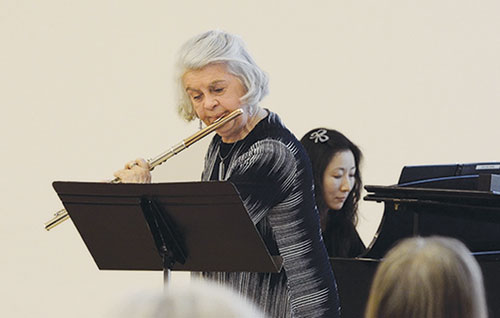
Carter Pann: I just saw Robert Dick at UC Boulder – I hosted him with my colleague, flutist Christina Jennings. This was the first time I got to see, in the flesh, this extended techniques master really go for it in a very small room like a private concert. These are techniques I rarely use no matter what I am writing for. I mean, what are extended techniques on piano? You stand up and do something inside of it. Other than that, it is really a woodwind, string, or percussionist thing. I use it very sparingly. I am still entranced by straight ahead musical expression. There is no other way to say it.
Katherine Hoover: Somebody asked me years ago what the difference is between what I am doing for the flute, and what Robert Dick is doing. I was thinking about it. He is interested in the language of the flute, and he is trying to establish a whole new language on the instrument. For me, it is all about telling some kind of story.
Carter Pann: You are absolutely right. He is a pioneer of the new. He is a real trailblazer in that regard.
What are your upcoming projects?
Katherine Hoover: I was very involved with the Colorado String Quartet and knew them well; I wrote two quartets and have recently done a piece for their first violinist Julie Rosenfield. I am also writing a new choral work. I got to know the New York Virtuoso Singers, a fabulous group. They recorded my Requiem for the Innocent (2001-2002) and some other pieces, and now I am writing more for them. I have also written a book of poetry, This Way About. I care a lot about the relationship of words and music, especially in my writing for chorus.
Jennifer Higdon: I am writing a low brass concerto for members of the Chicago Symphony Orchestra, and it is kicking my butt! My brain tends to be attracted to higher sounds because I was a flute player. Tackling the low end of the orchestra – three trombones and a tuba – is a lot to balance. It gives me a different angle for looking at what is going on in an orchestra. I like those kinds of challenges. Normally I say yes to the projects that scare the daylights out of me. I met with the players and asked them what they would like, and they all mentioned “Could you give us something soft and melodic?” That was interesting and not what you would expect them to say.
Carter Pann: Staring me in the face is something a little less frightening: A new, Third String Quartet and a work just signed, sealed, and delivered for wind ensemble called At Her Ladyship’s Request. I was into the show Downton Abbey and love that era. I also have three upcoming premieres. SDG Music Foundation has commissioned a new trio for flute, cello, and piano titled Melodies for Robert to be premiered by Jennie Oh Brown, Kurt Fowler, and Jennifer Blyth in October 2017. Christina Jennings will premiere a new encore for flute and piano called, Double Espresso, and the Flute New Music Consortium has commissioned a new work titled Giantess for flute and piano to be premiered at Indiana University of Pennsylvania by Terri Wacker, flute, in March 2018.
***
Katherine Hoover was the recipient of the 2016 NFA Lifetime Achievement Award.
Pulitzer Prize winner Jennifer Higdon’s music can be heard performed by the world’s leading orchestras.
Carter Pann was a 2016 Pulitzer Prize finalist and looks forward to three commissioned premieres for flute in the upcoming season, including Giantess for flute and piano written for the Flute New Music Consortium.
